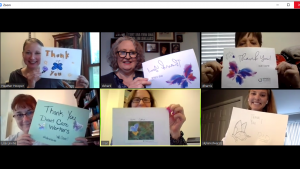Butterflies are powerful representations of life. Around the world, in many cultures and faiths, the butterfly represents endurance, change, hope, and life.
Direct care workers—formally classified as personal care aides, home health aides, and nursing assistants, but known in the field by a much broader array of job titles—provide assistance with activities of daily living (ADLs) and instrumental activities of daily living (IADLs) across care settings. Their role requires considerable technical skill, especially as consumers’ acuity increases, but also an extensive set of interpersonal skills. These skills are essential for building relationships with individuals and their families; communicating effectively with other members of the care team; managing conflicts and crises; and more.
Every day, nearly 4.5 million direct care workers support older adults and people with disabilities across the United States. Their role is invaluable to the individuals they support, their families, and the long-term care system—and to our economy and society. Yet direct care workers are often overlooked, their contribution unrecognized, and their efforts under compensated:
- Nearly 20 million adults in the United States require assistance completing self-care and other daily tasks due to physical, cognitive, developmental, and/ or behavioral conditions
- Individuals with personal assistance needs rely first and foremost on family members, friends, and neighbors—a cadre of more than 43 million caregivers whose economic contribution is valued at $470 billion
- The direct care workforce, which is already sizable, is expanding rapidly as our population grows older. The workforce has already nearly doubled within a decade, from 2.9 million workers in 2008 to almost 4.5 million in 2018
- Looking ahead, the long-term care sector is expected to add a further 1.3 million direct care jobs, primarily personal care aide positions, from 2018 to 2028—more new jobs than any other occupation in the U.S. economy
Despite this staggering need and the importance of their contribution, direct care workers continue to struggle for recognition. Historically defined as low-skill workers, 42% of direct care workers require some form of public assistance due to low earnings and high rates of poverty. According to the most recent data from the Bureau of Labor Statistics, the median wage for all direct care workers is $12.27 per hour and—due to high rates of part-time employment as well as low wages—median annual earnings are just $20,200.

Please join us in thanking those directly caring for the sick during this pandemic. Simply find, or create an image of a butterfly along with the words “thank you” and take a photo of yourself, your family, or your team and post it to social media as a sign of support for those working the front lines of this virus. Be sure to tag us and anyone you want to thank specifically. #danccares


